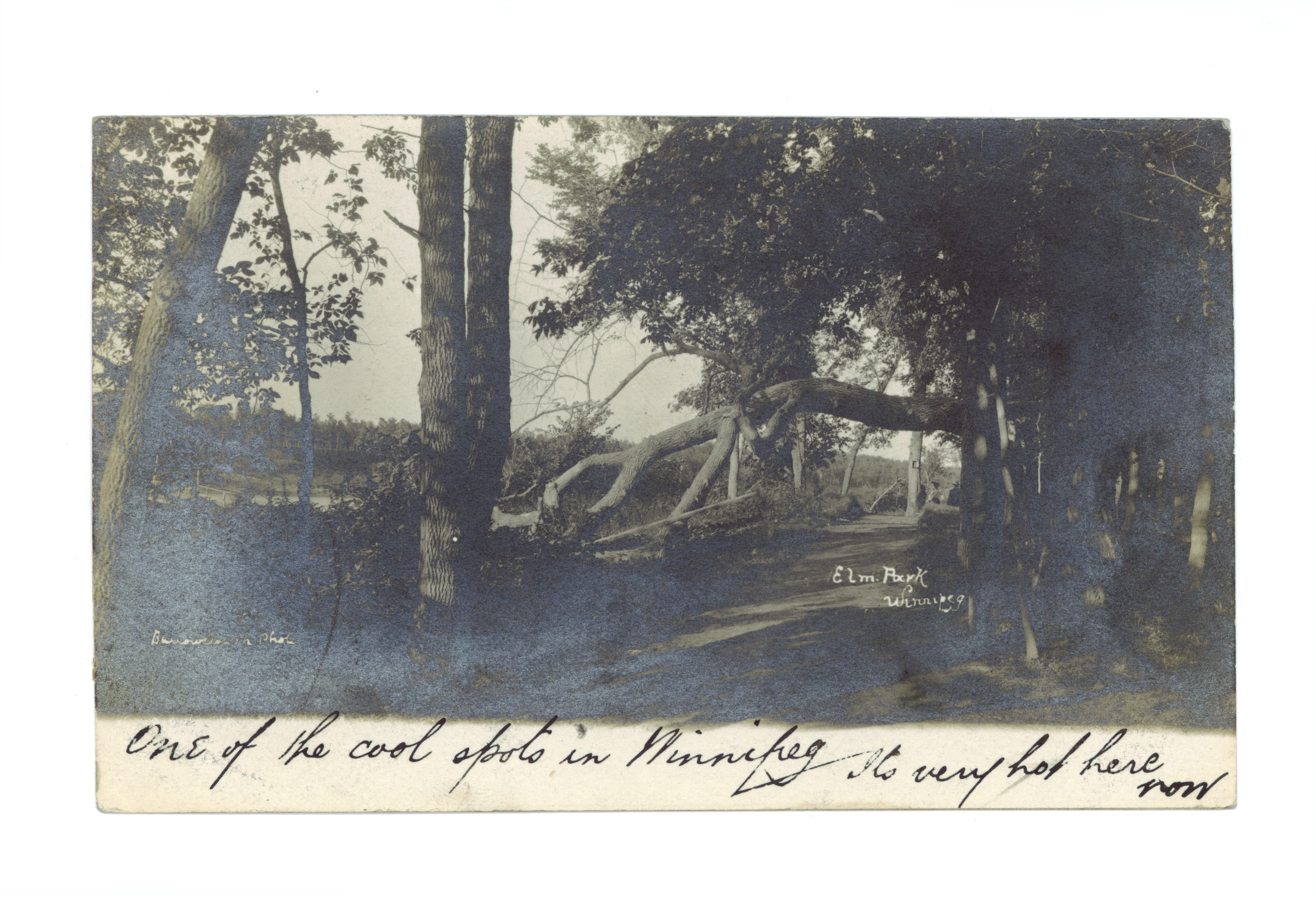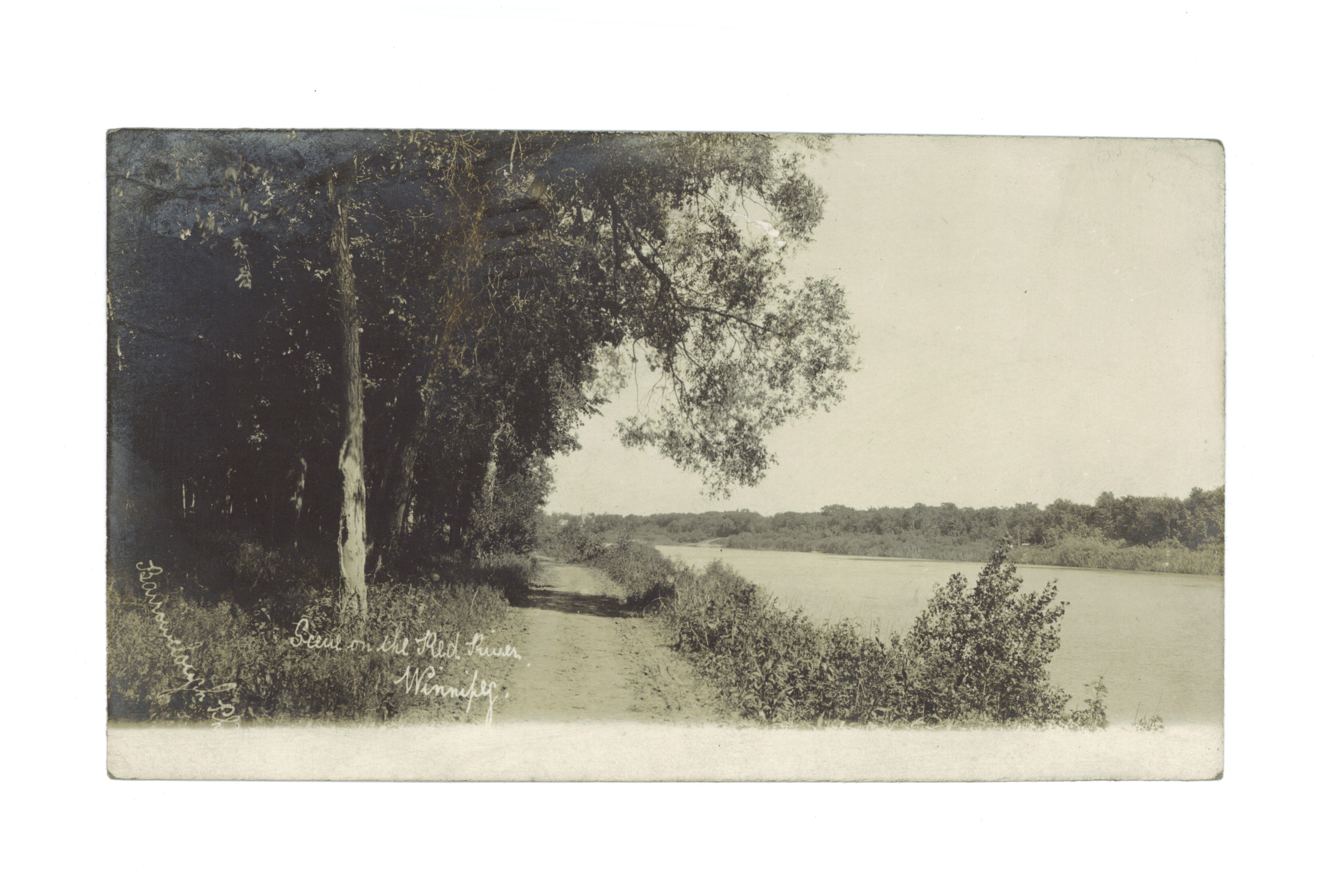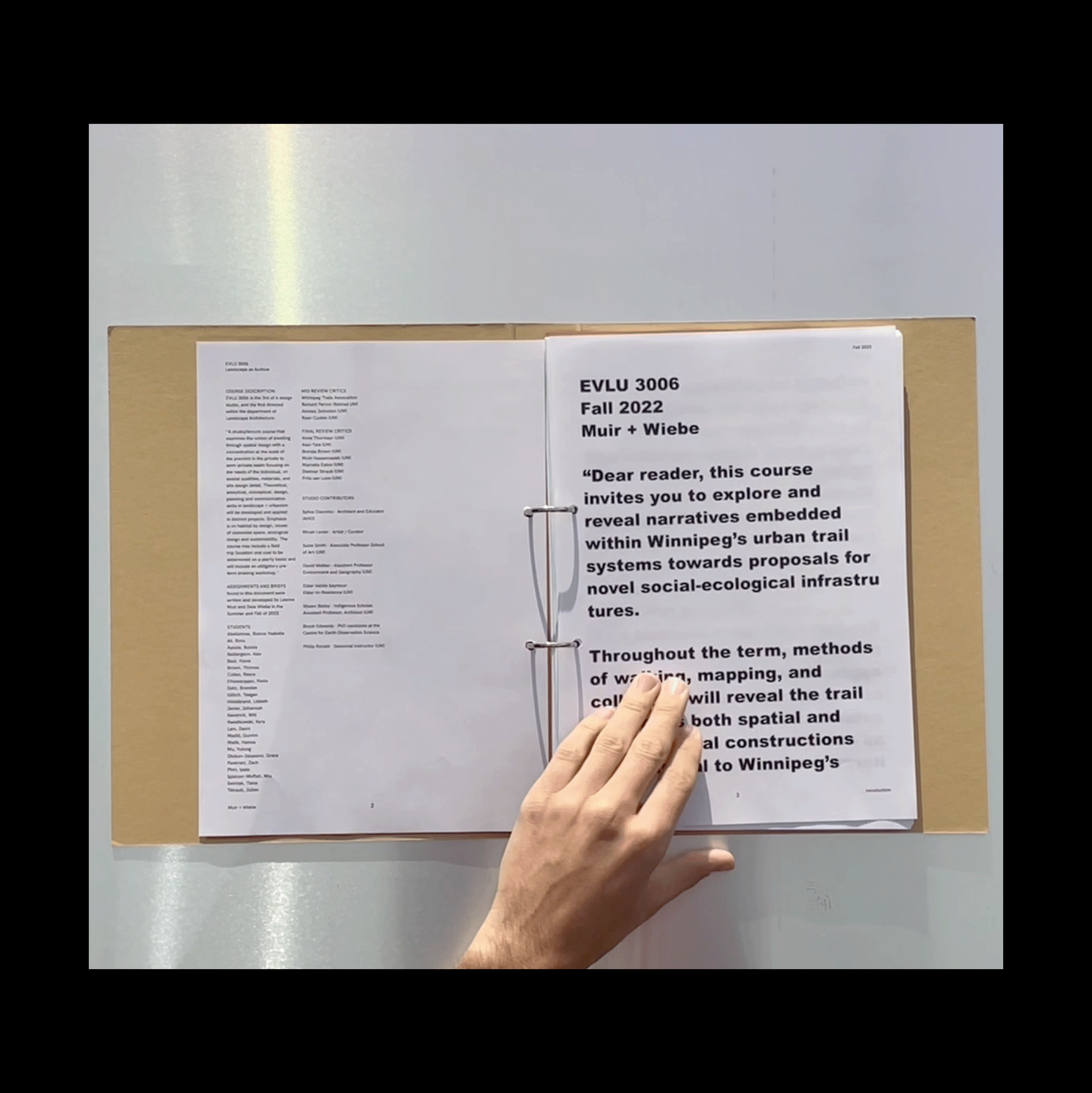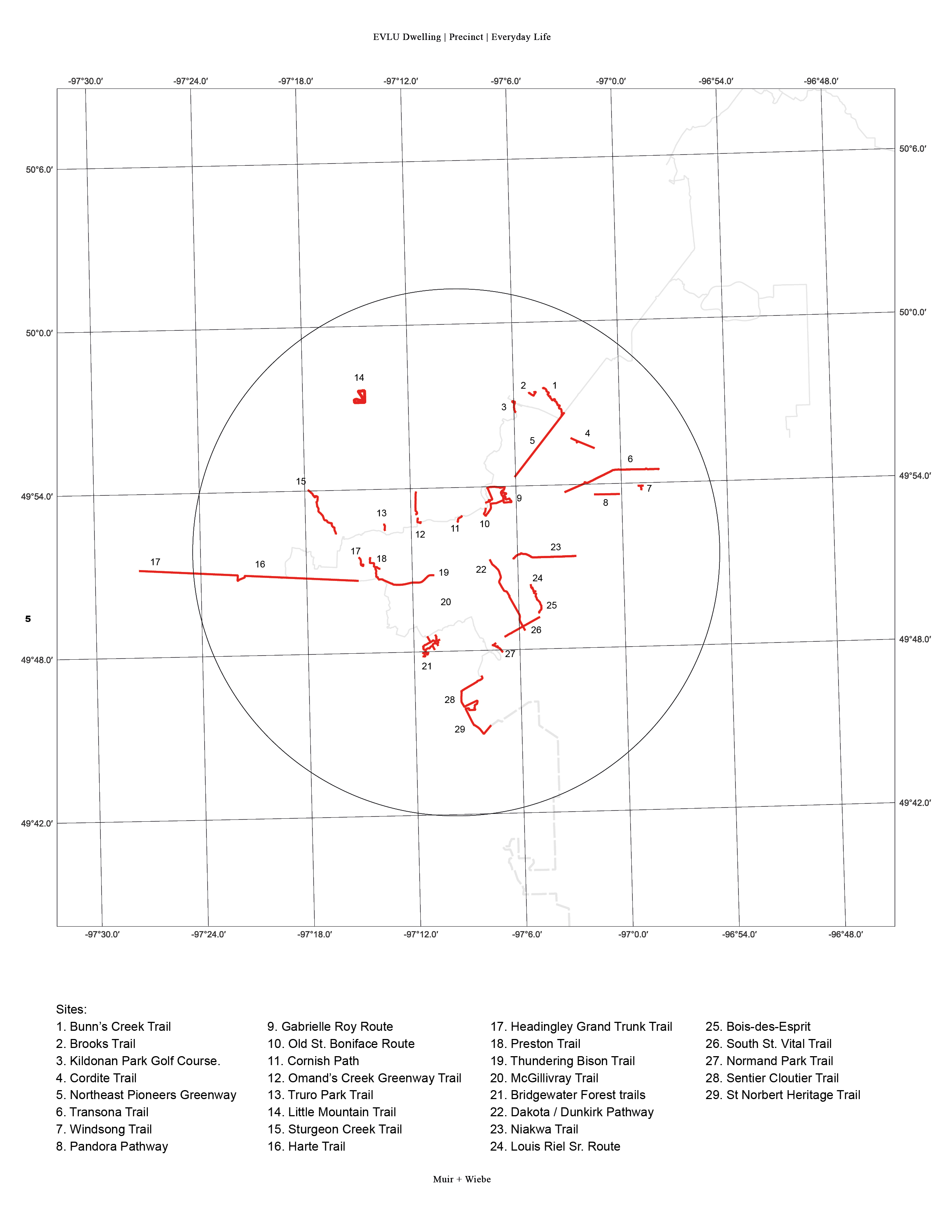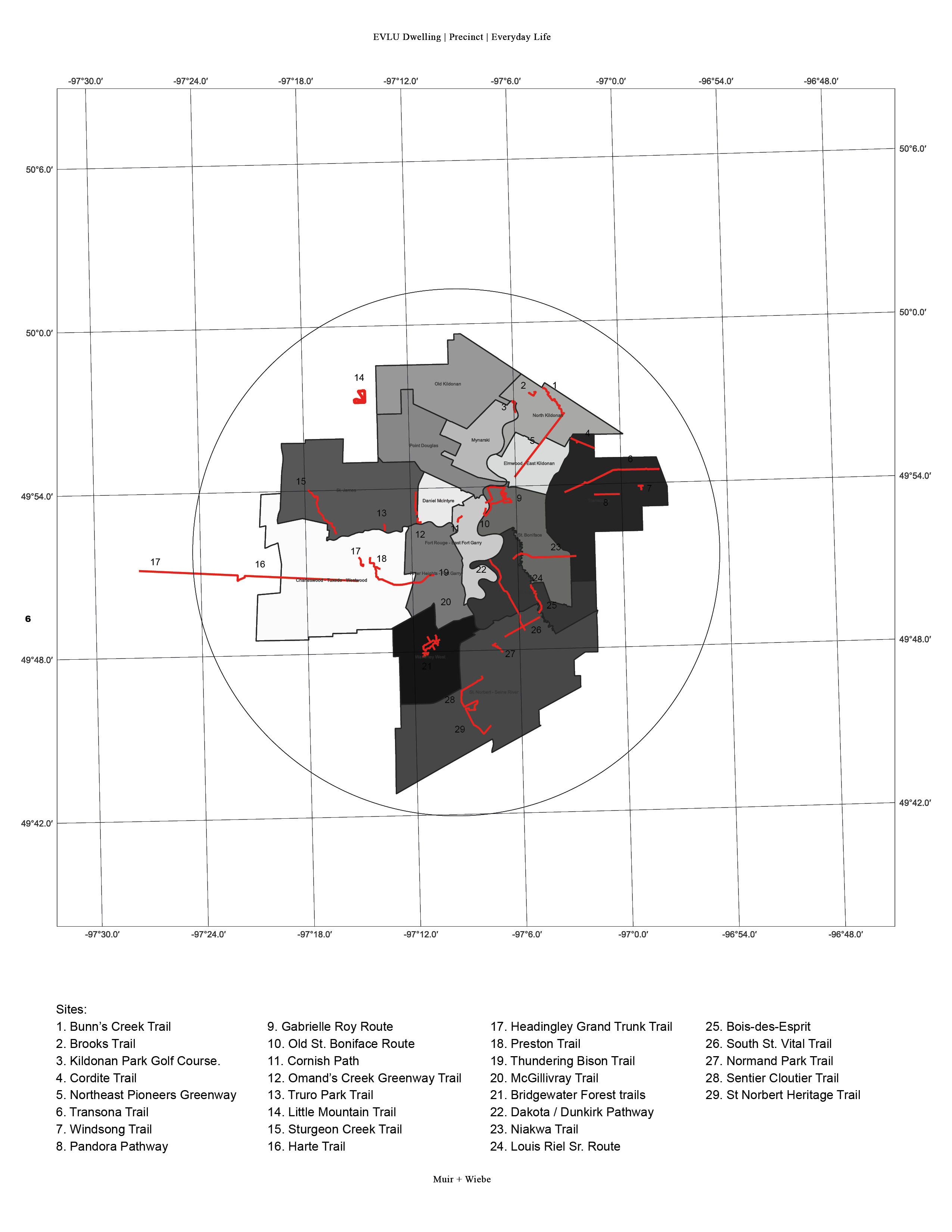LAA
Landscape As Archive
“This studio is about maps, trails, walking, collecting, editing, listening, looking and seeing. The course invites you to explore and reveal hidden narratives embedded within Winnipeg’s urban trail systems towards proposals for novel social-ecological urban infrastructures. Throughout the term, mapping and walking will be used as speculative tools, linking spatial understanding to the formation of landscape and urbanism.
Benton MacKaye’s foundational work on the Appalachian Trail provides historical context for understanding a network of trails as more than simply outdoor recreation. MacKaye’s original vision was embedded with social idealism and delivered as a strategic regional plan, aiming:
to put back together the various parts of American life that were rapidly coming undone in the early 20th century. It would fuse leisure and industry, environment and labor, community development and wilderness preservation into an interrelated project. It would rebalance the vampiric relationship between city and hinterland, and align the dimensions of regional planning with the geography of ecological zones rather than political jurisdictions. (1)
In 1992, The Trans Canada Trail began formalized construction linking historical paths, abandoned rail lines and newly built trails, stitching together 27,000 km. By 2017, the trail was deemed complete, a line connecting oceans through intersecting
political boundaries
territories,
ecosystems,
neighbourhoods,
communities.
With this regional and nationalcontext, we will explore Winnipeg’s urban trails, as identified by the Winnipeg Trails Association, as the focus of our work this term. We will investigate these sites and their entrenched physical and psychological structures through careful walking, mapping, and collecting, and we will build an understanding of the traces, stories, and objects embedded in the landscapes. With this nuanced direction, we will find soft, less apparent narratives to promote, allowing us to modify and refocus the trails according to our findings.
This studio is about care and subtlety - finding small things that may be overlooked, following them as detours, and perhaps blowing them out of proportion. Ultimately, we will be working towards the vision of the Winnipeg Trails Association to design places where
the natural world and human dignity are so important…that we design our transportation systems to eliminate every possible barrier – …where we can always hear the sound of conversation, go safely to work or see a loved one, where birds and animals of every kindabound, where night skies and clean water are protected, and where simple pleasures – like smelling fresh air orswimming in our rivers – are once again the norm. (2)
The context for this work includes ongoing funding initiatives from the provincial government into trail
infrastructure within Winnipeg and across Manitoba, together with the environmental and social realities of
the climate crisis, and ongoing efforts towards Truth and Reconciliation. Throughout the term, we invite you to be slow and intentional, playful, and experimental, and to lean into the opportunity to dig deep and allow curiosity and intuition to be your leader. At the conclusion of the studio, we will assemble the work into an Atlas of Future Landscape Archives for Winnipeg’s urban trails.”
“This studio is about maps, trails, walking, collecting, editing, listening, looking and seeing. The course invites you to explore and reveal hidden narratives embedded within Winnipeg’s urban trail systems towards proposals for novel social-ecological urban infrastructures. Throughout the term, mapping and walking will be used as speculative tools, linking spatial understanding to the formation of landscape and urbanism.
Benton MacKaye’s foundational work on the Appalachian Trail provides historical context for understanding a network of trails as more than simply outdoor recreation. MacKaye’s original vision was embedded with social idealism and delivered as a strategic regional plan, aiming:
to put back together the various parts of American life that were rapidly coming undone in the early 20th century. It would fuse leisure and industry, environment and labor, community development and wilderness preservation into an interrelated project. It would rebalance the vampiric relationship between city and hinterland, and align the dimensions of regional planning with the geography of ecological zones rather than political jurisdictions. (1)
In 1992, The Trans Canada Trail began formalized construction linking historical paths, abandoned rail lines and newly built trails, stitching together 27,000 km. By 2017, the trail was deemed complete, a line connecting oceans through intersecting
political boundaries
territories,
ecosystems,
neighbourhoods,
communities.
With this regional and nationalcontext, we will explore Winnipeg’s urban trails, as identified by the Winnipeg Trails Association, as the focus of our work this term. We will investigate these sites and their entrenched physical and psychological structures through careful walking, mapping, and collecting, and we will build an understanding of the traces, stories, and objects embedded in the landscapes. With this nuanced direction, we will find soft, less apparent narratives to promote, allowing us to modify and refocus the trails according to our findings.
This studio is about care and subtlety - finding small things that may be overlooked, following them as detours, and perhaps blowing them out of proportion. Ultimately, we will be working towards the vision of the Winnipeg Trails Association to design places where
the natural world and human dignity are so important…that we design our transportation systems to eliminate every possible barrier – …where we can always hear the sound of conversation, go safely to work or see a loved one, where birds and animals of every kindabound, where night skies and clean water are protected, and where simple pleasures – like smelling fresh air orswimming in our rivers – are once again the norm. (2)
The context for this work includes ongoing funding initiatives from the provincial government into trail
infrastructure within Winnipeg and across Manitoba, together with the environmental and social realities of
the climate crisis, and ongoing efforts towards Truth and Reconciliation. Throughout the term, we invite you to be slow and intentional, playful, and experimental, and to lean into the opportunity to dig deep and allow curiosity and intuition to be your leader. At the conclusion of the studio, we will assemble the work into an Atlas of Future Landscape Archives for Winnipeg’s urban trails.”
2022
MID REVIEW CRITICS
Winnipeg Trails Association
Richard Perron (Retired UM)
Ainsley Johnston (UM)
Ryan Coates (UM)
FINAL REVIEW CRITICS
Anna Thurmayr - landscape (UM)
Alan Tate (UM)
Brenda Brown (UM)
Moin Hassanzadeh (UM)
Marcella Eaton (UM)
Dietmar Straub (UM)
Frits van Loon (UM)
STUDIO CONTRIBUTORS
Syliva Diacontu - Architect and Educator
(AHO)
Micah Lexier - Artist / Curator
Suzie Smith - Associate Professor School
of Art (UM)
David Walker - Assistant Professor
Environment and Geography (UM)
Elder Valdie Seymour-
Elder-in-Residence (UM)
Shawn Bailey - Indigenous Scholar,
Assistant Professor, Architect (UM)
Brock Edwards - PhD candidate at the
Centre for Earth Observation Science
Philip Ronald - Sessional instructor (UM)
